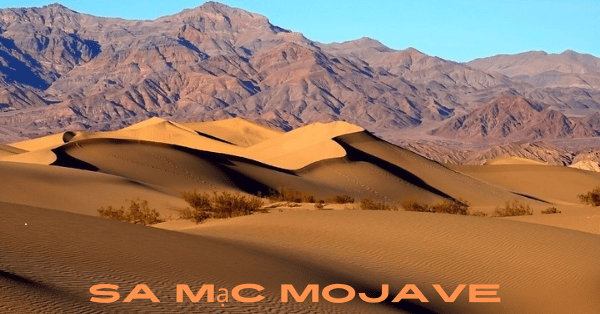The Mojave Desert, known in Vietnamese as Sa Mạc Mojave, is one of the most iconic deserts in North America. This vast, arid landscape boasts unique geological formations, diverse ecosystems, and a rich cultural history across California, Nevada, Arizona, and Utah. Despite its harsh conditions, the Mojave has become a hotspot for adventurers, researchers, and nature enthusiasts.
Location and Size of Sa Mạc Mojave
The Mojave Desert covers approximately 47,877 square miles, making it one of the largest deserts in the United States. It lies between the Sierra Nevada, Colorado Plateau, and Great Basin, creating a natural boundary for its arid terrain.
Unique Climate of Sa Mạc Mojave
The desert experiences extreme temperatures, with summer highs often exceeding 120°F (49°C) and winter nights dropping below freezing. Its unique climate is shaped by the rain shadow effect from surrounding mountain ranges, resulting in minimal precipitation, often less than 5 inches annually.
The Joshua Tree: Symbol
The Joshua tree, a unique species of yucca, is a defining feature of the Mojave Desert. These quirky, tree-like plants thrive in the region and are integral to the desert’s identity. They also play a crucial role in the local ecosystem by providing habitat for various species.
Geological Wonders of Sa Mạc Mojave
The Mojave is home to stunning geological features like Death Valley, North America’s hottest and driest place. Other notable landmarks include the Kelso Dunes, which produce a haunting “singing” sound, and the iconic Mojave National Preserve, known for its lava tubes and unique rock formations.
Flora and Fauna
Despite its arid conditions, the Mojave Desert supports a surprising variety of life. Plants such as creosote bushes, cacti, and wildflowers bloom in the desert, while animals like desert tortoises, kangaroo rats, and coyotes adapt to the harsh environment. The seasonal wildflower bloom is a spectacular sight that attracts tourists worldwide.
Cultural Significance
Their cultural heritage is evident in rock art, petroglyphs, and traditional practices celebrating the land. Today, the desert remains a symbol of resilience and adaptability.
Tourism in Sa Mạc Mojave
Adventure seekers flock to the Mojave for hiking, camping, and stargazing. National parks like Joshua Tree National Park and Death Valley National Park offer unparalleled opportunities to connect with nature. Off-road enthusiasts and photographers also find the Mojave a paradise for exploration.
Challenges Facing Sa Mạc Mojave
Despite its rugged beauty, the Mojave Desert faces numerous threats, including climate change, habitat destruction, and over-tourism. Rising temperatures and human activities are disrupting delicate ecosystems, putting native species at risk.
Renewable Energy in Sa Mạc Mojave
The Mojave Desert is a hub for renewable energy projects, particularly solar and wind energy. Its sunny and windy conditions make it an ideal location for sustainable energy initiatives. However, balancing energy development with environmental conservation remains a challenge.
Astronomical Significance of Sa Mạc Mojave
The Mojave’s clear skies and minimal light pollution make it a popular destination for astronomers. Observatories and stargazing enthusiasts frequent the area to witness breathtaking celestial displays, from meteor showers to the Milky Way.
Legends and Mysteries of Sa Mạc Mojave
The Mojave is steeped in legends, from tales of lost gold mines to reports of UFO sightings. These mysteries add an air of intrigue to the desert, drawing curious adventurers seeking more than just natural beauty.
Hollywood’s Love Affair with Sa Mạc Mojave
The Mojave’s dramatic landscapes have been the backdrop for countless films and television shows. From Westerns to sci-fi epics, the desert’s unique charm continues to captivate filmmakers and audiences alike.
Preservation Efforts
Various organizations and initiatives are dedicated to preserving the Mojave’s unique ecosystem and cultural heritage. Conservation efforts focus on protecting wildlife, restoring habitats, and raising awareness about the importance of the desert of the desert.
Why Sa Mạc Mojave is a Must-Visit Destination
Whether you’re an adventurer, a nature lover, or simply seeking a tranquil escape, the Mojave Desert offers an unforgettable experience. Its rugged beauty, diverse wildlife, and cultural significance make it a destination.
Conclusion
The Mojave Desert, or Sa Mạc Mojave, is more than just an arid expanse; it’s a testament to nature’s resilience and adaptability. Its unique climate, diverse ecosystems, and cultural heritage offer endless opportunities for exploration and appreciation. As we face environmental challenges, preserving this natural wonder is crucial for future generations.
FAQs
Q1: What makes the Mojave Desert unique?
The Mojave is unique for its extreme climate, diverse ecosystems, and iconic features, such as Joshua Tree and Death Valley.
Q2: Can you visit the Mojave Desert year-round?
Yes, but visitors should prepare for extreme temperatures in summer and cold nights in winter.
Q3: Are there any endangered species in the Mojave?
Yes, species like the desert tortoise are considered endangered and are protected under conservation efforts.
Q4: What activities can you do in the Mojave Desert?
Popular activities include hiking, camping, off-roading, stargazing, and exploring historical landmarks.
Q5: How can I help preserve the Mojave Desert?
You can support conservation efforts by respecting wildlife, minimizing waste, and donating to organizations that preserve desert habitats.



